Indoor vine plants are the secret to bringing a fresh, vibrant atmosphere to your home. These versatile plants are known for their ability to climb, cascade, and drape, offering a unique way to fill empty spaces with lush greenery. Whether hanging from the ceiling, trailing down a bookshelf, or climbing up a trellis, indoor vines are not only beautiful but also functional.
The benefits of indoor vine plants go beyond just aesthetics. They help purify the air, making your home feel fresher and cleaner. Their growth habits are also space-saving, allowing them to thrive in tight corners, on walls, or suspended from ceilings, making them perfect for small apartments or cozy rooms.
In this article, we will highlight 15 beautiful indoor vine plants that will bring life and beauty to your indoor spaces. From low-maintenance options to more striking varieties, there’s something for everyone to enjoy!
1. Swedish Ivy (Plectranthus verticillatus)
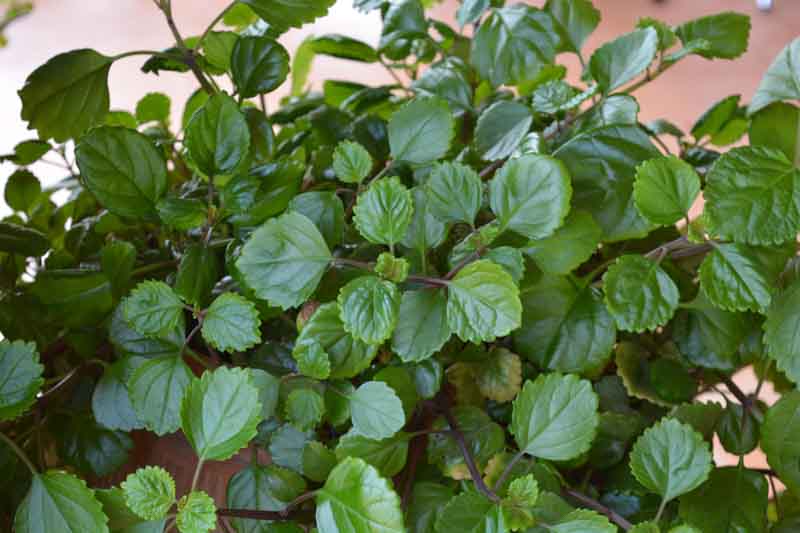
Swedish Ivy (Plectranthus verticillatus) is a stunning indoor vine that thrives in bright, indirect light. Known for its fast-growing, cascading habit, this plant adds a touch of elegance and texture to any space. With its soft, scalloped leaves, it creates a lovely contrast against other plants, making it a standout addition to your indoor garden.
Why Choose Swedish Ivy for Your Home?
- Fast-Growing & Cascading Habit: Swedish Ivy quickly establishes a trailing, lush appearance, perfect for shelves, hanging baskets, or cascading down a wall.
- Light & Water Requirements: This plant prefers bright, indirect light, so place it near a window without direct sunlight. Regular watering keeps it healthy, but make sure the soil is well-drained.
- Textural Appeal: The soft, scalloped leaves of Swedish Ivy add a unique texture, complementing other plants or standing out on their own.
Whether you’re looking to fill a corner or add a pop of greenery to a hanging planter, Swedish Ivy is an ideal choice. With minimal care and maximum impact, it’s a must-have for your indoor plant collection!
2. Creeping Fig (Ficus pumila)

Creeping Fig (Ficus pumila) is a versatile small-leaved vine that can easily cling to surfaces, making it an excellent choice for creating a lush, green wall effect in your home. This fast-growing vine is perfect for adding greenery to bare walls, trellises, or hanging baskets, offering both beauty and texture.
Why You’ll Love Creeping Fig in Your Home?
- Small-Leaved Vine: Creeping Fig’s tiny, heart-shaped leaves give it a delicate yet dense appearance. Its ability to cling to surfaces makes it ideal for creating natural green walls or decorative trellises.
- Lush, Green Wall Effect: If you’re looking for a vibrant and organic aesthetic, this vine can transform any space by adding a cascading flow of greenery that brings life to your walls.
- Pruning for Control: Creeping Fig is a fast grower, so regular pruning will help keep it in check and maintain a neat, controlled look without overwhelming your space.
Whether you’re looking to add charm to a bare corner or cover a feature wall with natural greenery, Creeping Fig is a low-maintenance plant that brings a touch of nature into your home.
3. English Ivy (Hedera helix)
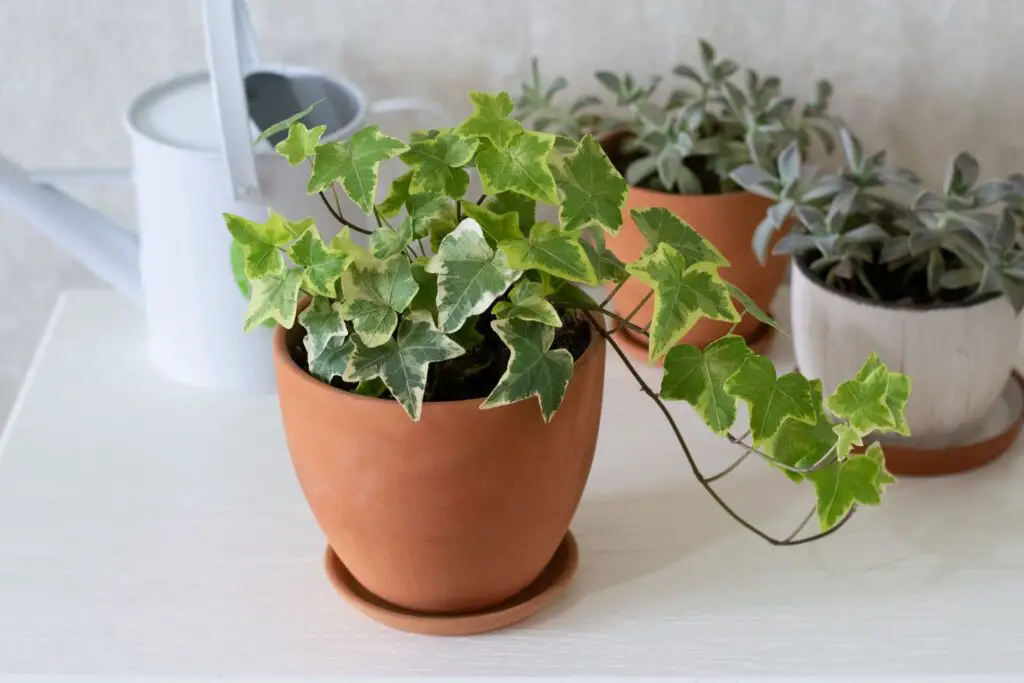
English Ivy (Hedera helix) is a timeless, elegant trailing vine that adds a touch of sophistication to any room. With its rich green leaves and cascading vines, it’s the perfect choice for creating a lush, natural aesthetic indoors. This versatile plant is best grown in cooler indoor conditions, making it ideal for spots that don’t get too warm.
Why English Ivy Is a Must-Have for Your Home?
- Classic, Elegant Appearance: English Ivy is known for its graceful, trailing vines and deep green foliage. Whether cascading from a hanging basket or winding around a trellis, it’s a plant that never goes out of style.
- Cooler Indoor Conditions: English Ivy thrives in cooler temperatures, ideally between 50°F and 70°F (10°C to 21°C). Keep it away from heat sources like radiators and direct sunlight to ensure it remains healthy and vibrant.
- Tips for Preventing Legginess: To maintain a bushy, full appearance, trim back long or leggy vines regularly. This will encourage new growth and prevent the plant from becoming sparse. Pruning also helps maintain its tidy, lush look.
English Ivy’s timeless beauty and easy care make it a great choice for adding a touch of elegance and greenery to any part of your home. With a little attention, it will thrive and become a stunning focal point in your indoor space.
4. Betel Leaf Plant (Piper betle)

The Betel Leaf Plant (Piper betle) is a unique and versatile vine known for its edible leaves and medicinal uses. Originating from tropical climates, this plant thrives in warm, humid conditions, making it perfect for indoor spaces with the right environment. Not only does it offer a fresh addition to your plant collection, but its leaves also have culinary and health benefits.
Why Betel Leaf Plant is a Great Addition to Your Home?
- Edible & Medicinal: Betel leaves are used in many cultures for their health benefits, often chewed for their stimulant properties. The leaves can also be used in various dishes for a distinctive flavor.
- Warm, Humid Conditions: This plant thrives in warmth and humidity, so it’s ideal for spots like kitchens or bathrooms where temperature and moisture levels are naturally higher.
- Benefits of Regular Pruning: To encourage healthy growth and maintain a lush, compact shape, regular pruning is essential. Trim back older stems and leaves to stimulate new growth and prevent overcrowding. Pruning also helps keep the plant from becoming too leggy or unruly.
With its unique combination of beauty, practicality, and health benefits, the Betel Leaf Plant is an excellent addition to any indoor garden, offering both aesthetic appeal and useful properties.
5. Inch Plant (Tradescantia zebrina)
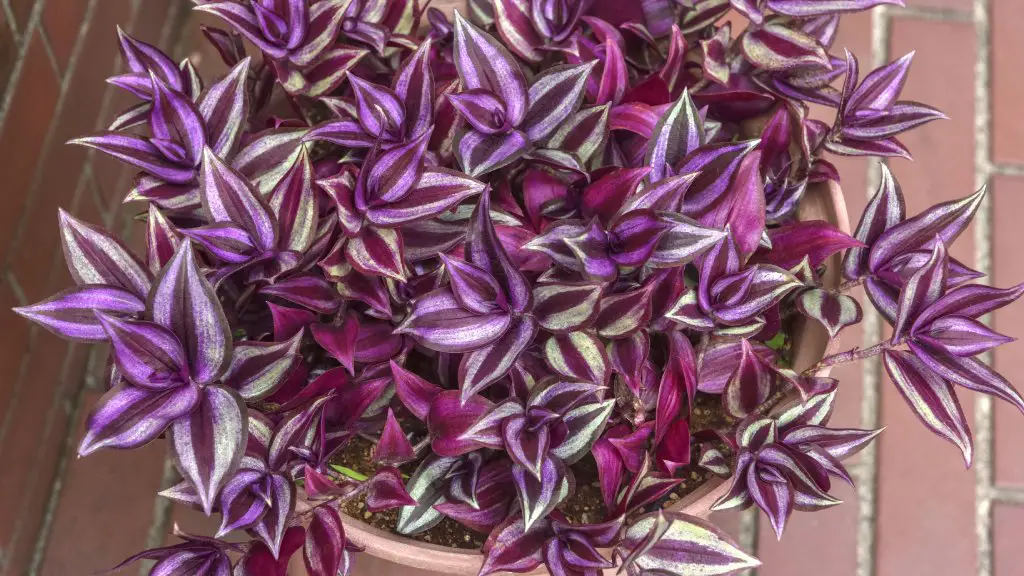
The Inch Plant (Tradescantia zebrina) is a striking indoor vine that boasts vibrant purple and silver-striped leaves, making it a standout addition to any home. Known for its fast growth and low-maintenance care, it’s an excellent choice for both beginner and experienced plant lovers.
Why You’ll Love Inch Plant in Your Home?
- Striking Purple and Silver-Striped Leaves: The bold, contrasting colors of the Inch Plant’s leaves make it a showstopper in any room. The deep purple and silvery stripes add a touch of elegance and vibrancy to your indoor garden.
- Low-Maintenance & Fast-Growing: Inch Plant thrives with minimal care, making it an ideal choice for busy individuals or plant beginners. Its rapid growth allows it to quickly fill out hanging baskets or cascade over shelves, adding natural beauty to your home.
- Bright, Indirect Light: This plant prefers bright, indirect light, so place it near a window with filtered sunlight to ensure its colors stay vibrant and the plant remains healthy.
With its striking foliage and easy care, the Inch Plant is a perfect addition for anyone looking to brighten up their space with a low-maintenance, fast-growing beauty.
6. Passionflower (Passiflora spp.)
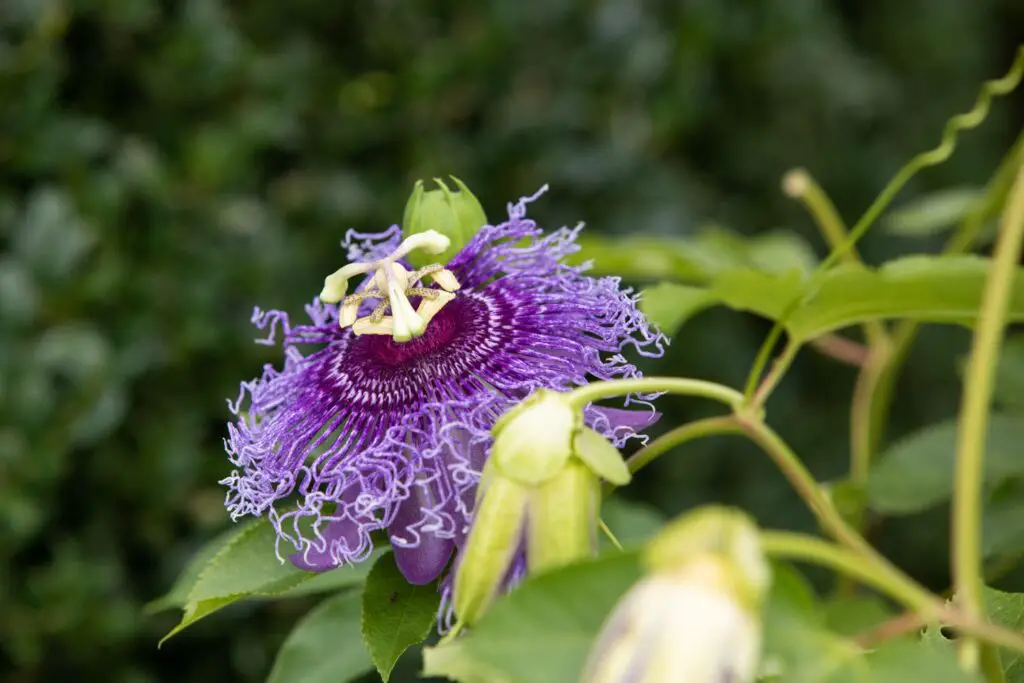
Passionflower (Passiflora spp.) is a stunning and exotic vine known for its intricate, vibrant flowers and rapid growth. It’s a captivating plant that can add a burst of color and energy to your indoor garden, but it does require some care and attention to thrive in your home.
Why Passionflower is a Showstopper in Your Home?
- Exotic-Looking Flowers: Passionflower’s unique, intricate blooms are unlike any other. The vibrant colors and detailed patterns make it a true statement piece in any room, adding a touch of exotic charm to your space.
- Rapid Growth: This vine grows quickly and vigorously, making it an ideal choice for anyone looking to fill vertical space with lush greenery. It will climb and spread, so be prepared for it to cover trellises, walls, or hanging supports.
- Bright Light and Climbing Support: Passionflower needs bright, indirect light to flourish. As a climbing vine, it will require some form of support, such as a trellis or stake, to allow its vines to grow upward and outward.
- Occasional Pruning: To keep the plant manageable indoors and encourage new blooms, regular pruning is recommended. Trim back any excessive growth to maintain a tidy appearance and prevent the vine from becoming too unruly.
Passionflower’s striking blooms and rapid growth make it a bold addition to any indoor garden, offering beauty and intrigue with every new flower. With proper care, it can be a long-lasting and stunning part of your plant collection.
Related Topics:
7. Curtain Creeper (Tarlmounia elliptica)
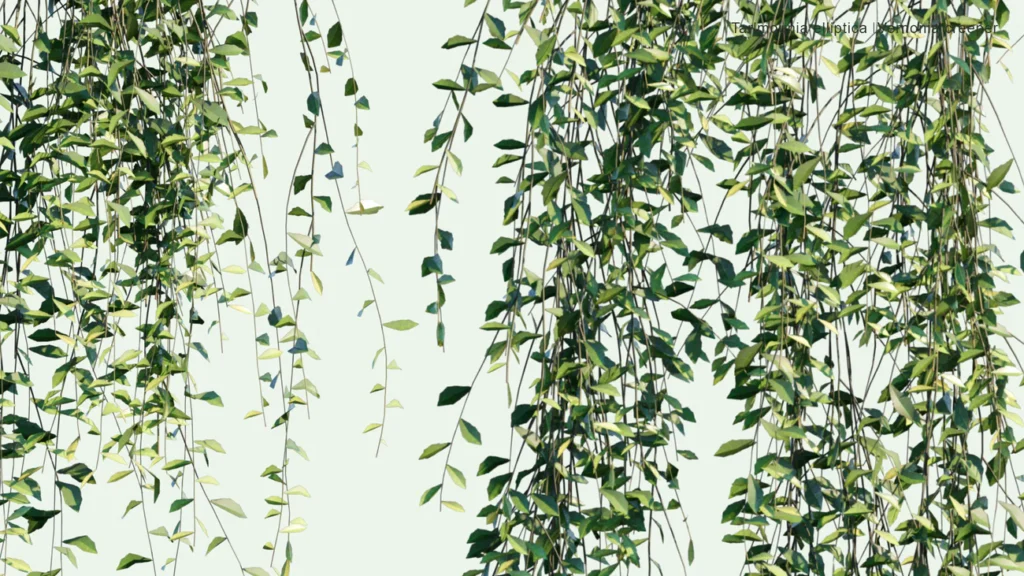
The Curtain Creeper (Tarlmounia elliptica) is an eye-catching vine that features dense, curtain-like trailing foliage, making it an ideal plant for adding vertical greenery and texture to your space. With its fast growth and unique appearance, it’s perfect for creating a lush, natural ambiance indoors.
Why Curtain Creeper is Perfect for Your Home?
- Dense, Curtain-Like Foliage: The Curtain Creeper’s thick, cascading leaves form a beautiful curtain effect, making it an excellent choice for covering bare walls or adding greenery to hanging baskets.
- Bright Light Preference: To thrive, Curtain Creeper requires bright, indirect light. Place it near a window where it can receive sufficient light, but avoid direct sunlight, which may scorch its leaves.
- Occasional Trimming: This fast-growing vine can quickly become overgrown if not properly managed. Regular trimming helps prevent excessive growth, keeping the plant tidy and encouraging healthy, bushy foliage.
Whether draping over a trellis or hanging from a shelf, Curtain Creeper adds a lush, natural touch to any room, offering both beauty and low-maintenance care. With a little attention, it will transform your indoor space into a green oasis.
8. Monstera Adansonii (Swiss Cheese Vine)
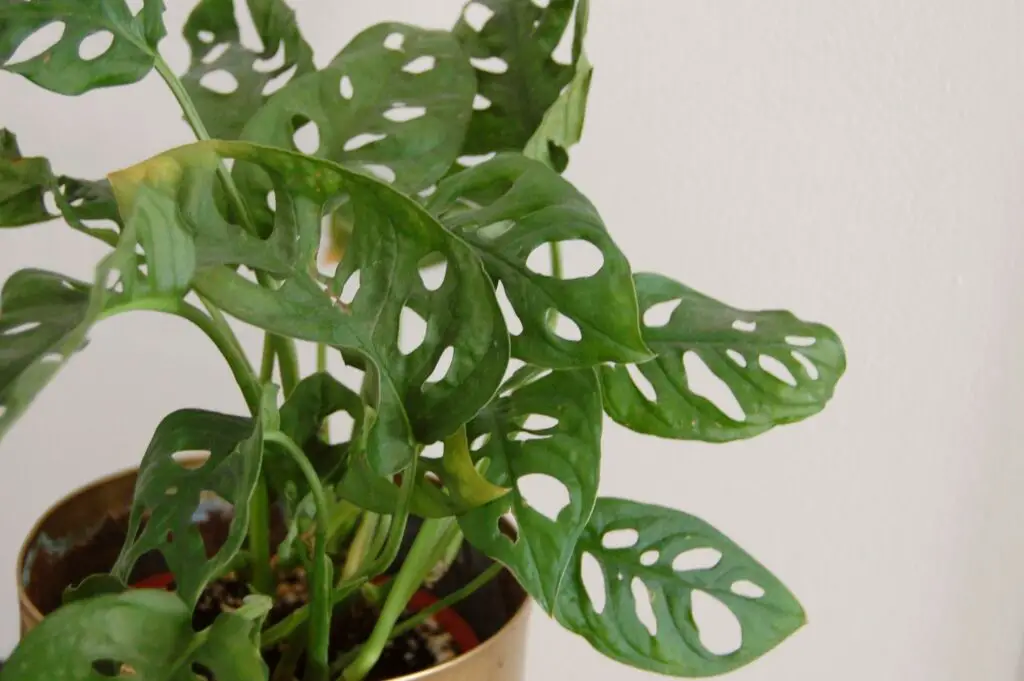
Monstera Adansonii, also known as the Swiss Cheese Vine, is a popular indoor vine renowned for its striking fenestrated (hole-punched) leaves that add a tropical, exotic flair to any space. Its fast growth and ability to adapt to indoor environments make it an excellent choice for plant lovers looking to add a touch of the tropics to their home.
Why Monstera Adansonii is a Must-Have for Your Home?
- Unique Fenestrated Leaves: The distinctive hole-punched leaves of the Monstera Adansonii give it a one-of-a-kind appearance. These dramatic, tropical leaves bring a lush, rainforest vibe to your living space.
- Thrives in Humid, Indirect Light: This plant loves humid conditions, so it’s perfect for bathrooms, kitchens, or any area with higher moisture levels. It also prefers bright, indirect light, so place it near a window with filtered sunlight for optimal growth.
- Training on a Trellis: Monstera Adansonii naturally climbs and spreads, so providing a trellis or support structure enhances its growth, encouraging the vines to grow upward and produce larger, more pronounced fenestrated leaves.
With its unique look and ability to adapt to indoor spaces, Monstera Adansonii is the perfect plant to add an exotic, tropical feel to your home while requiring minimal maintenance.
9. String of Pearls (Senecio rowleyanus)
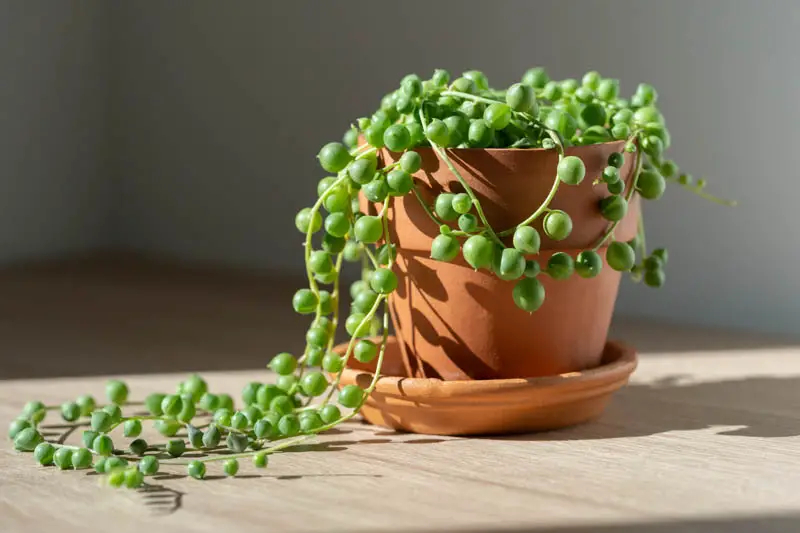
String of Pearls (Senecio rowleyanus) is an eye-catching and unique trailing succulent, known for its distinctive bead-like leaves that resemble pearls strung along delicate vines. This charming plant adds an interesting texture and a touch of whimsy to your indoor garden, making it a must-have for succulent lovers.
Why String of Pearls is a Showstopper in Your Home?
- Bead-Like Trailing Vines: The string of small, round, bead-like leaves gives this plant its signature look. These trailing vines make it an ideal choice for hanging baskets, shelves, or cascading from planters, creating a dramatic effect.
- Bright Light & Well-Draining Soil: String of Pearls thrives in bright, indirect light, so place it near a window with plenty of sunlight. It also requires well-draining soil to prevent root rot, making a cactus or succulent mix ideal.
- Watering Tips: Overwatering is a common mistake with String of Pearls, so it’s important to let the soil dry out completely between waterings. Water sparingly, especially in the winter when the plant is in a dormant phase. Be sure to check the moisture level of the soil before adding more water to avoid root rot.
With its unique, striking appearance and minimal care requirements, String of Pearls is a fun and low-maintenance addition to your indoor garden. Just be mindful of watering, and this beauty will thrive!
10. Devil’s Backbone (Pedilanthus tithymaloides)
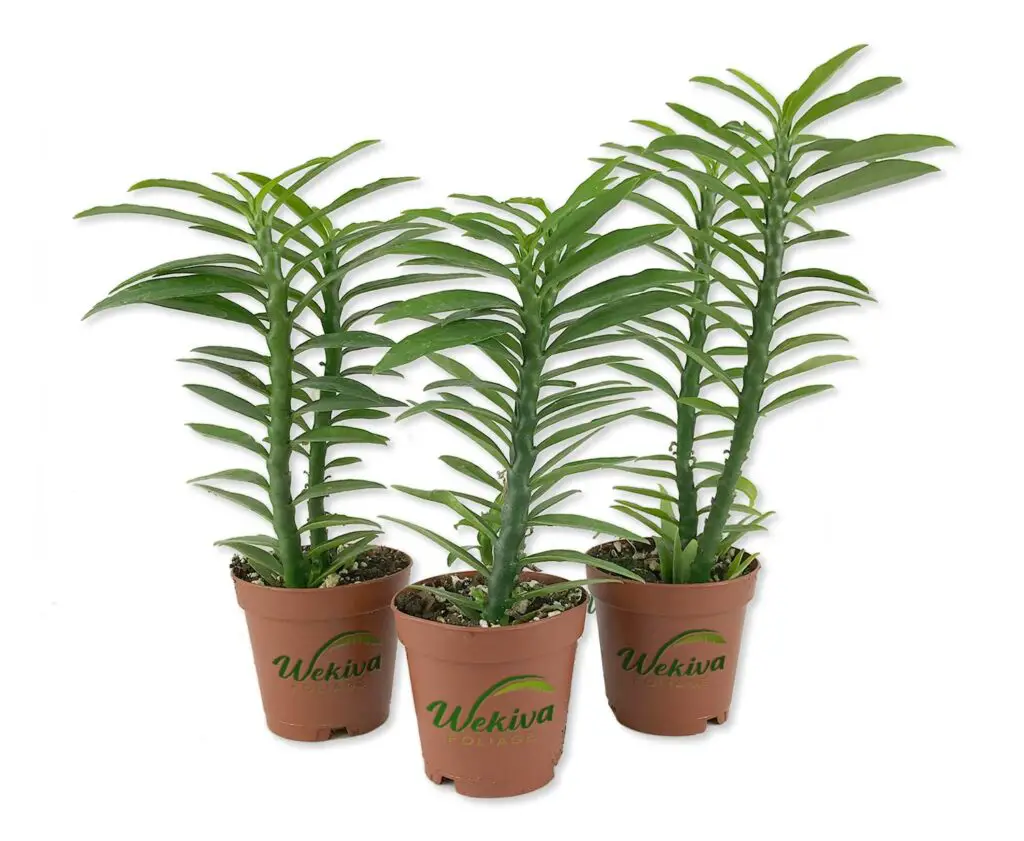
Devil’s Backbone (Pedilanthus tithymaloides) is an intriguing and unique vine known for its zigzagging stems and variegated leaves. This hardy plant is perfect for beginners due to its minimal care requirements and its ability to thrive in dry, warm conditions. It’s an excellent choice for anyone looking to add a quirky touch to their indoor garden with little effort.
Why Devil’s Backbone is Perfect for Your Home?
- Zigzagging Stems & Variegated Leaves: The plant’s distinctive zigzag stems, paired with its green and yellow variegated leaves, create a unique look that stands out in any room. It’s perfect for adding architectural interest to shelves, windowsills, or hanging planters.
- Thrives in Dry, Warm Conditions: Devil’s Backbone is well-suited to dry, warm environments, making it an ideal plant for sunny spots in your home. It is highly drought-tolerant and doesn’t need frequent watering, so it’s great for those with a busy lifestyle.
- Minimal Care for Beginners: With its low-maintenance nature, Devil’s Backbone is perfect for beginners. Simply provide it with bright, indirect light, and let the soil dry out between waterings. Occasional pruning helps maintain its shape, but otherwise, this plant is easy to care for and forgiving.
Devil’s Backbone brings both a unique look and a no-fuss attitude to your indoor garden, making it a fantastic option for anyone looking for an eye-catching yet low-maintenance plant.
11. Rex Begonia Vine (Cissus discolor)
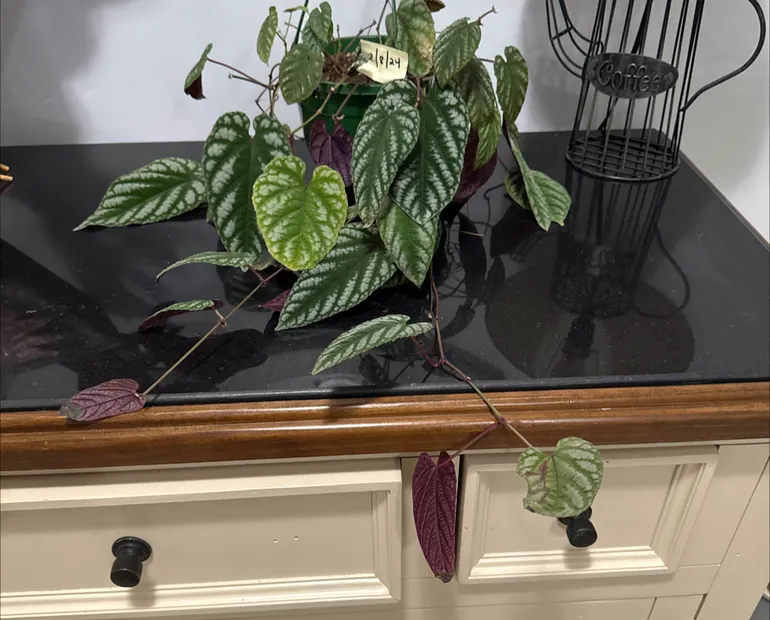
The Rex Begonia Vine (Cissus discolor) is a striking addition to any indoor plant collection, known for its velvety leaves adorned with silver markings and deep purple undersides. This unique plant brings a touch of elegance and drama to your home, especially when provided with the right conditions to thrive.
Why Rex Begonia Vine is a Must-Have for Your Home?
- Stunning Velvety Leaves: The Rex Begonia Vine features lush, velvety green leaves with eye-catching silver markings and rich purple undersides, adding a bold and luxurious look to any room.
- Loves Warmth & Humidity: This plant thrives in warm, humid conditions, making it perfect for bathrooms or kitchens where humidity is higher. It also appreciates consistent warmth and will flourish in temperatures ranging from 60°F to 85°F (15°C to 29°C).
- Indirect Light & Climbing Support: Rex Begonia Vine prefers bright, indirect light, so place it in a well-lit spot away from direct sun. It’s a natural climber, so providing a trellis or other support will encourage the vines to grow upward and maintain a lush, cascading appearance.
With its beautiful foliage and low-maintenance care, the Rex Begonia Vine is a perfect choice for adding a touch of tropical elegance and color to your home.
12. Black-Eyed Susan Vine (Thunbergia alata)
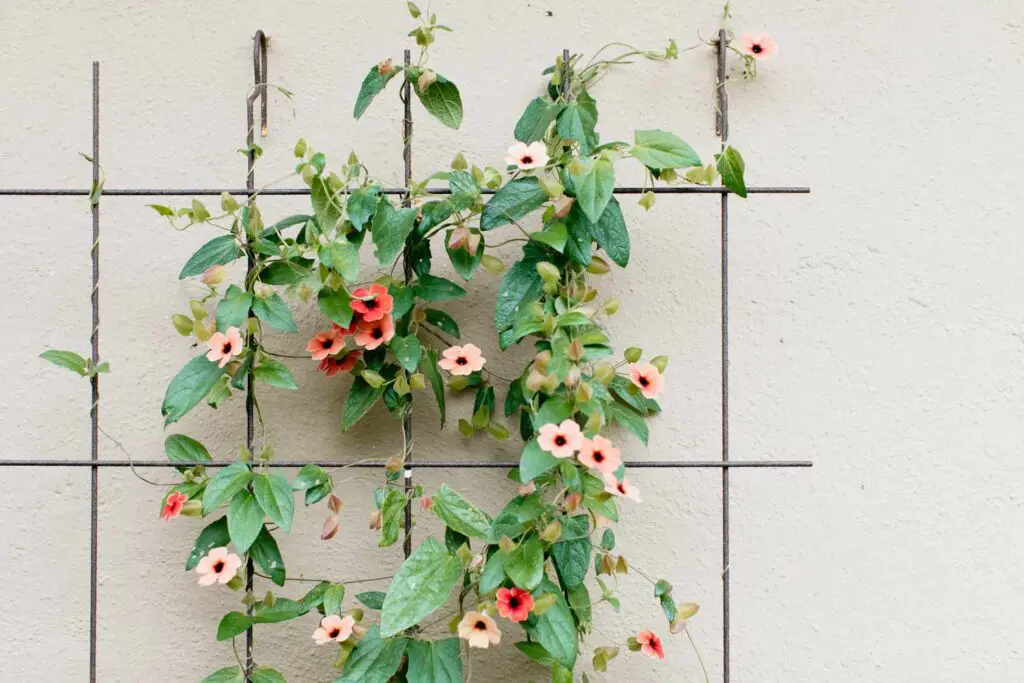
The Black-Eyed Susan Vine (Thunbergia alata) is a stunning addition to any indoor plant collection, known for its fast-growing vines and vibrant flowers in shades of yellow, orange, or white. This colorful and lively vine is perfect for brightening up your space with its bold blooms.
Why Black-Eyed Susan Vine is Perfect for Your Home?
- Vibrant Blooms: The Black-Eyed Susan Vine produces striking flowers in a variety of vibrant colors, including yellow, orange, and white, with dark centers resembling “black eyes.” These cheerful flowers can fill your space with color and energy.
- Fast-Growing: This vine grows quickly, making it a great choice for filling vertical spaces and adding a burst of greenery to your indoor garden. It’s perfect for trellises, hanging baskets, or cascading from shelves.
- Bright Light & Regular Watering: The Black-Eyed Susan Vine thrives in bright, indirect light. Keep the soil consistently moist but not soggy, as regular watering will help it flourish.
- Training for Climbing: This vine can easily be trained to climb trellises or other support structures, making it ideal for adding a vertical element to your indoor garden while encouraging its natural climbing habit.
With its bold flowers and fast growth, the Black-Eyed Susan Vine is sure to be a captivating addition to your plant collection, bringing both beauty and a splash of color to your home.
13. Rosary Vine (Ceropegia linearis subsp. woodii)
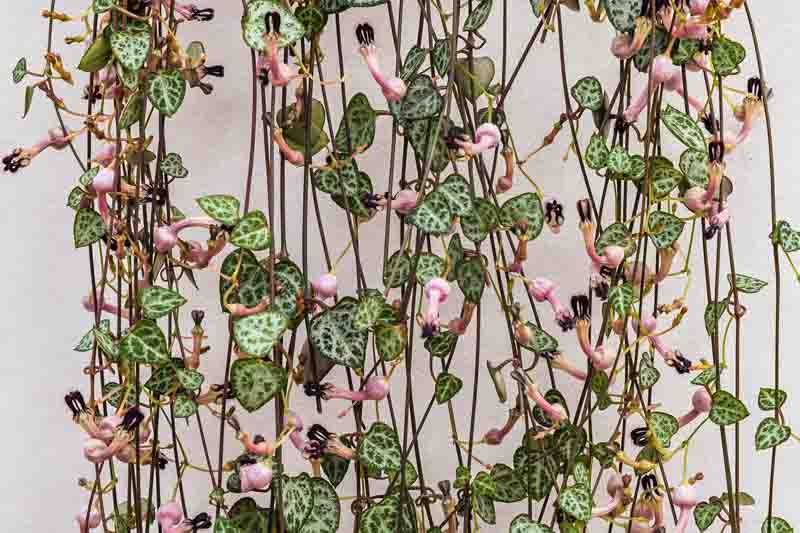
The Rosary Vine (Ceropegia linearis subsp. woodii) is a stunning addition to any indoor garden, known for its long, trailing stems and thinner, elongated leaves that give it a delicate appearance similar to the String of Hearts. This vine’s graceful, cascading vines make it an ideal choice for hanging baskets or decorative planters.
Why Rosary Vine is Perfect for Your Home?
- Thinner, Elongated Leaves: Unlike the String of Hearts, the Rosary Vine has more slender, elongated leaves, giving it a light and airy feel while still maintaining that signature heart-shaped leaf appearance.
- Bright, Indirect Light: Rosary Vine thrives in bright, indirect light, so place it near a window with filtered sunlight for optimal growth. Avoid direct sunlight, which can scorch its delicate leaves.
- Minimal Watering: This plant is perfect for those looking for low-maintenance greenery. Rosary Vine requires minimal watering—just let the soil dry out completely between waterings to prevent root rot.
- Ideal for Hanging Baskets: With its long, trailing stems, the Rosary Vine looks fantastic in hanging baskets, where it can cascade freely and add a touch of elegance to your indoor garden.
With its delicate appearance and easy care requirements, the Rosary Vine is a beautiful and fuss-free addition to any home, perfect for adding greenery to shelves, windowsills, or hanging baskets.
14. Dutchman’s Pipe Cactus (Epiphyllum oxypetalum)

The Dutchman’s Pipe Cactus (Epiphyllum oxypetalum) is a captivating trailing cactus known for its thick, leafy stems and its stunning, fragrant white flowers that bloom at night. This unique plant combines the beauty of a jungle cactus with the intriguing allure of nighttime blooms, making it a perfect addition to any indoor garden.
Why Dutchman’s Pipe Cactus is a Must-Have for Your Home?
- Trailing, Jungle Cactus: Unlike typical cacti, the Dutchman’s Pipe Cactus has thick, fleshy stems that give it a more tropical, jungle-like appearance. Its trailing vines make it perfect for hanging baskets or cascading from shelves.
- Huge, Fragrant Night-Blooming Flowers: One of the most exciting features of this cactus is its large, fragrant white flowers that bloom in the evening. These blooms create a magical, aromatic atmosphere that can be enjoyed throughout the night.
- Loves Bright, Indirect Light: The Dutchman’s Pipe Cactus thrives in bright, indirect light, so place it near a window with plenty of filtered sunlight. Avoid direct sunlight to prevent damage to its delicate stems.
- Occasional Watering: This cactus requires minimal watering, making it easy to care for. Water it sparingly, allowing the soil to dry out completely between waterings to prevent overwatering.
With its unique look, stunning blooms, and minimal care requirements, the Dutchman’s Pipe Cactus is an excellent choice for those looking to add a touch of drama and fragrance to their indoor garden.
15.Purple Bell Vine (Rhodochiton atrosanguineus)
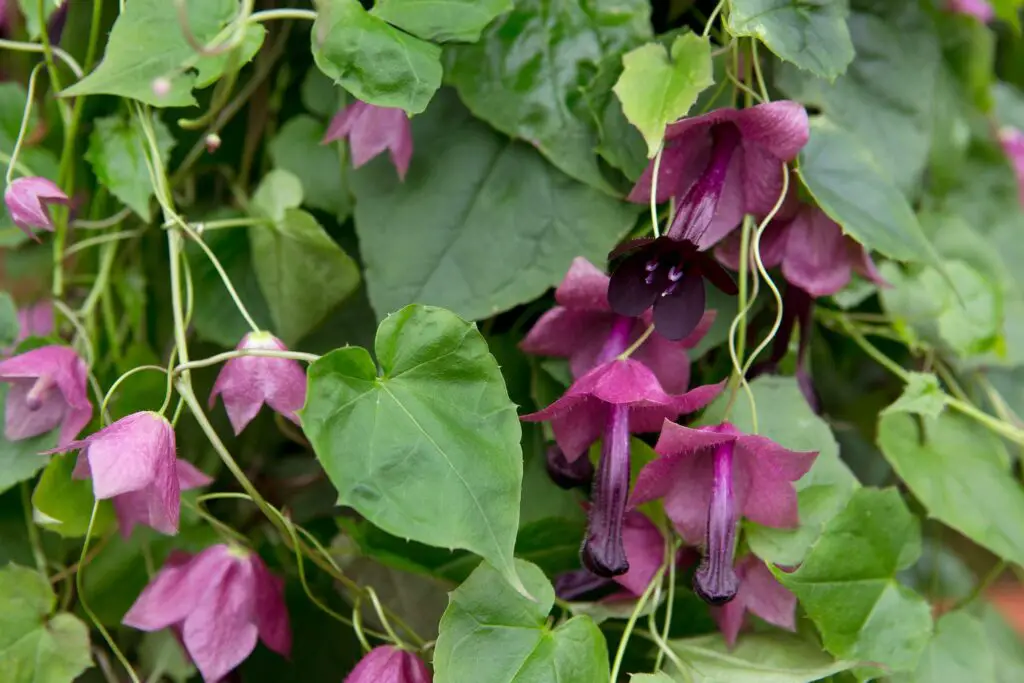
The Purple Bell Vine (Rhodochiton atrosanguineus) is a rare and captivating climbing vine that features deep purple, bell-shaped flowers. Known for its dramatic and exotic appearance, this vine is perfect for adding a splash of color and a touch of sophistication to your indoor garden.
Why Purple Bell Vine is a Showstopper for Your Home?
- Deep Purple, Bell-Shaped Flowers: The standout feature of the Purple Bell Vine is its striking deep purple, bell-shaped flowers that add a unique and dramatic element to any indoor space. These vibrant blooms bring an exotic flair to your plant collection.
- Prefers Bright, Indirect Light & Humidity: This vine thrives in bright, indirect light, so be sure to place it in a well-lit area, like near a window with filtered sunlight. It also enjoys higher humidity levels, making it ideal for spots like bathrooms or kitchens where moisture is naturally higher.
- Perfect for Trellises: The Purple Bell Vine is an excellent choice for climbing and looks amazing when trained on trellises or other support structures. It will create a stunning visual display, filling your space with color and drama.
With its rare beauty, vibrant flowers, and minimal care needs, the Purple Bell Vine is the perfect plant for adding a touch of elegance and intrigue to your indoor garden.
Embrace the Beauty of Indoor Vines:
Indoor vines are a fantastic way to bring the beauty of nature into your home without occupying too much space. Whether you’re drawn to classic trailing vines like Pothos or the exotic appeal of flowering climbers like the Purple Bell Vine, there’s a perfect plant to suit every style and space.
Final Care Tips for Thriving Vines:
- Proper Light: Ensure your vines get the right amount of light, typically bright, indirect light, to keep them healthy and vibrant.
- Occasional Pruning: Regular trimming will help maintain their shape and prevent overgrowth, keeping your vines looking neat and lush.
- Right Watering Schedule: Pay attention to your plants’ watering needs, allowing the soil to dry out between waterings for most varieties to prevent root rot.
With these simple care tips, your indoor vines will thrive, adding lush greenery, texture, and even beautiful blooms to your space.
FAQs:
1. What are the best indoor vine plants for beginners?
Answer: Some of the best indoor vine plants for beginners include Pothos, Heartleaf Philodendron, and Inch Plant. These are all low-maintenance, fast-growing, and adaptable to a variety of light conditions.
2. How often should I water indoor vine plants?
Answer: Indoor vines generally prefer to dry out slightly between waterings. Water when the top inch of the soil feels dry, but always check the specific care needs for each plant. Overwatering is one of the most common mistakes, so ensure the soil is well-draining and avoid letting the plant sit in water.
3. Can indoor vine plants grow in low light?
Answer: While many indoor vines can tolerate low light, they thrive best in bright, indirect light. Plants like Pothos, Heartleaf Philodendron, and Creeping Fig are more forgiving in lower light, but for optimal growth and health, it’s best to provide them with some natural light or supplement with grow lights if necessary.

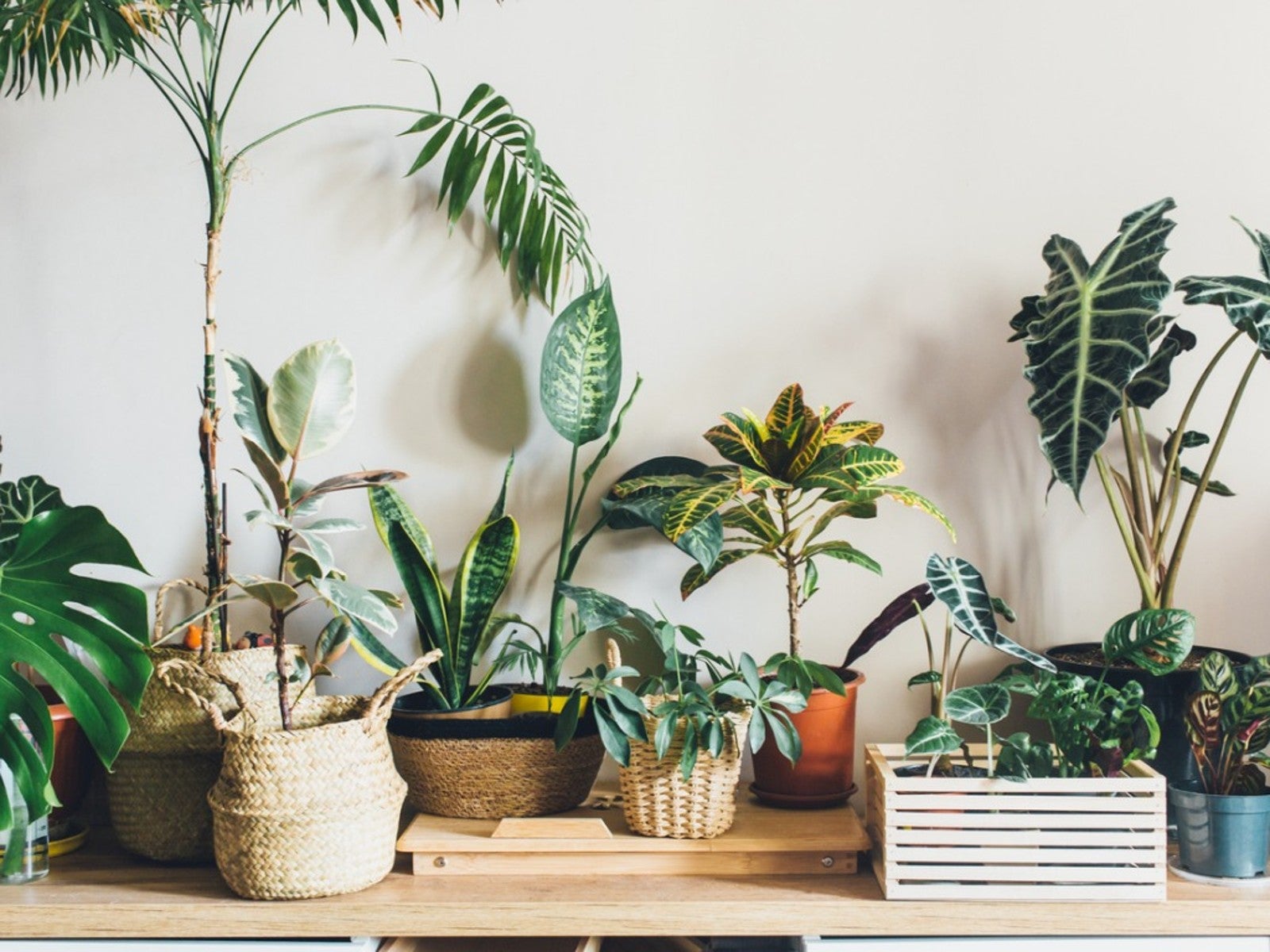
I’ve been waiting to feel your touch… ready? – https://rb.gy/es66fc?impaws